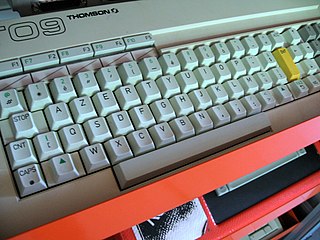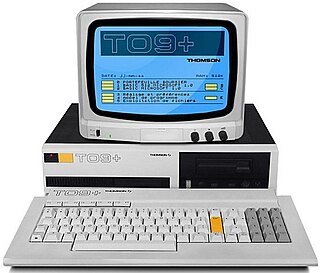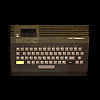
The Apple III is a business-oriented personal computer produced by Apple Computer and released in 1980. Running the Apple SOS operating system, it was intended as the successor to the Apple II series, but was largely considered a failure in the market. It was designed to provide key features business users wanted in a personal computer: a true typewriter-style upper/lowercase keyboard and an 80-column display.

The Atari ST is a line of personal computers from Atari Corporation and the successor to the Atari 8-bit family. The initial model, the Atari 520ST, had limited release in April–June 1985 and was widely available in July. It was the first personal computer with a bitmapped color GUI, using a version of Digital Research's GEM from February 1985. The Atari 1040ST, released in 1986 with 1 MB of RAM, was the first home computer with a cost-per-kilobyte of less than US$1.

The Amiga 500, also known as the A500, is the first low-end version of the Amiga home computer. It contains the same Motorola 68000 as the Amiga 1000, as well as the same graphics and sound coprocessors, but is in a smaller case similar to that of the Commodore 128.

UAE is a computer emulator which emulates the hardware of Commodore International's Amiga range of computers. Released under the GNU General Public License, UAE is free software.

The Matra & Hachette Ordinateur Alice is a home computer sold in France beginning in 1983. It was a clone of the TRS-80 MC-10, produced through a collaboration between Matra and Hachette in France and Tandy Corporation in the United States.

The Apple IIGS, the fifth and most powerful of the Apple II family, is a 16-bit personal computer produced by Apple Computer. While featuring the Macintosh look and feel, and resolution and color similar to the Amiga and Atari ST, it remains compatible with earlier Apple II models. The "GS" in the name stands for "Graphics and Sound", referring to its enhanced multimedia hardware, especially its state-of-the-art audio.

The Enterprise is a Zilog Z80-based home computer announced in 1983, but through a series of delays, not commercially available until 1985. The specification as released was powerful and one of the higher end in its class. This was due to the use of ASICs for graphics and sound which took workload away from the CPU, an extensive implementation of ANSI BASIC and a bank switching system to allow for larger amounts of RAM than the Z80 natively supported. It also featured a distinctive and colourful case design, and promise of multiple expansion options. Ultimately it was not commercially successful, after multiple renames, delays and a changing market place. Its manufacturer calling in the receivers in 1986 with significant debt. It was developed by British company Intelligent Software and marketed by Enterprise Computers. Its two variants are the Enterprise 64, with 64 kilobytes of Random Access Memory (RAM), and the Enterprise 128, with 128 KB of RAM.

The X68000 is a home computer created by Sharp Corporation. It was first released in 1987 and sold only in Japan.

The ThomsonMO5 is a home computer introduced in France in June 1984 to compete against systems such as the ZX Spectrum and Commodore 64. It had a release price of 2390 FF.

The Thomson EF936x series is a type of Graphic Display Processor (GDP) by Thomson-EFCIS. The chip could draw at 1 million pixels per second, which was relatively advanced for the time of its release. There are various versions of the chip, with slightly different capabilities.
The Sharp MZ is a series of personal computers sold in Japan and Europe by Sharp beginning in 1978.
Amiga emulation refers to the activity of emulating a Commodore Amiga computer system using another computer platform. Most emulators run on modern systems such as Microsoft Windows or Macintosh. This allows Amiga users to use their existing software, and in some cases hardware, on modern computers.
Atari 8-bit computer peripherals include floppy drives, printers, modems, and video game controllers for Atari's 8-bit computer family, which includes the 400/800, XL, XE, and XEGS.
Hombre is a RISC chipset for the Amiga, designed by Commodore, which was intended as the basis of a range of Amiga personal computers and multimedia products, including a successor to the Amiga 1200, a next generation game machine called CD64 and a 3D accelerator PCI card. Hombre was canceled along with the bankruptcy of Commodore International.

The Thomson TO7, also called Thomson 9000 is a home computer introduced by Thomson SA in November 1982, with an original retail price of 3750 FF. By 1983 over 40000 units were produced. About 84 games were released for the TO7.

The ThomsonMO6 was a Motorola 6809E-based computer introduced in France in 1986. It was intended as the successor to the Thomson MO5 and featured 128 KB of RAM, a 40×25 text display, and a new built-in Microsoft BASIC interpreter. It retained compatibility with its predecessor, while incorporating the same technology as the TO8.

In the 1980s the French Thomson company produced a range of 8-bit computers based on the 6809E CPU.

The Thomson TO9 is a home computer introduced by French company Thomson SA in 1985.

The Thomson TO9+ is a home computer introduced by French company Thomson SA in 1986. It kept the professional look of the Thomson TO9 by using a separate keyboard.
The Thomson TO16 or Thomson TO16PC is a PC compatible personal computer introduced by French company Thomson SA in 1987, with prices ranging from 9000 to 16000 FF depending on the version.
















